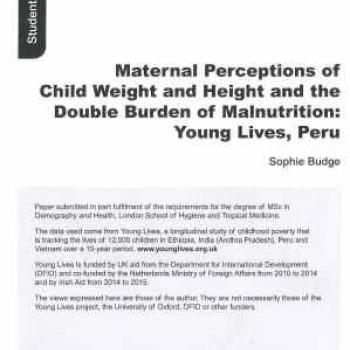
Levels of overweight and obesity continue to rise for most countries worldwide, whilst throughoutmany regions undernutrition persists. This has resulted in the "double burden": the coexistence of undernutrition as (stunting) and excess weight. In the Latin American region, particularly in Peru, the double burden within children looms as a serious public health problem. Research suggests that the increase in obesity is related to a decrease in parental awareness, however little research describes child stunting and overweight as comorbidities, nor correlates maternal perceptions of child weight and height with objective longitudinal change. This is pertinent as the double burden escalates.
The Peru Young Lives (Niños del Milenio) is one segment of a multi-national, longitudinal cohort study: this report uses data from rounds 1-3 for the younger cohort only (n=2049 at round 1). Anthropometric data collected at each round was used to calculate child BMI-/height-for-age zscores and maternal BMI. Maternal perceptions of child height and weight were asked at round 1 and 1 and 2 respectively. For analysis, descriptive statistics described demographics and child BMI-/height-for-age at rounds 1 and 2 and Pearson?s chi2 tested maternal perceptions with child BMI-forage.Accuracy of maternal perception of weight was calculated and binary logistic regression tested incorrect perception as a predictor of child weight gain at round 3.
Of the 2037 children included from round 1, 28.8% were found to be stunted: this was recognised by less than half of mothers. Subsequently at round 2, a greater proportion of stunted children were overweight or obese. Mothers of both non- and stunted children consistently overestimated child height (p=<0.001) but were more likely to underestimate weight in stunted children (p=<0.001). By round 3, stunted children whose mothers had previously incorrectly estimated their weight were almost three and a half times more likely to have gained weight (p=0.016). Multivariate analyses indicated that incorrect maternal weight perception correlated to a two and a half times higher odds (p=<0.001, 95% CI 1.81 ? 3.07) and height misperception a 1.36 odds (95% CI 1.06 ? 1.76) of a later overweight or obese child.
The results indicate that in Peru, a country experiencing high economic growth and the double burden of malnutrition, high child stunting prevalence is correlated with increased odds of future excess weight as compared with normal height children. This likelihood was strongly related to an inability of the mother to correctly perceive the weight and height of her child; it is likely that this tendency to underestimate paves the way for subsequent obesity. Results may be of interest for public health interventions aimed at tackling the double burden of malnutrition in Peru and neighbouring Andean countries.

Levels of overweight and obesity continue to rise for most countries worldwide, whilst throughoutmany regions undernutrition persists. This has resulted in the "double burden": the coexistence of undernutrition as (stunting) and excess weight. In the Latin American region, particularly in Peru, the double burden within children looms as a serious public health problem. Research suggests that the increase in obesity is related to a decrease in parental awareness, however little research describes child stunting and overweight as comorbidities, nor correlates maternal perceptions of child weight and height with objective longitudinal change. This is pertinent as the double burden escalates.
The Peru Young Lives (Niños del Milenio) is one segment of a multi-national, longitudinal cohort study: this report uses data from rounds 1-3 for the younger cohort only (n=2049 at round 1). Anthropometric data collected at each round was used to calculate child BMI-/height-for-age zscores and maternal BMI. Maternal perceptions of child height and weight were asked at round 1 and 1 and 2 respectively. For analysis, descriptive statistics described demographics and child BMI-/height-for-age at rounds 1 and 2 and Pearson?s chi2 tested maternal perceptions with child BMI-forage.Accuracy of maternal perception of weight was calculated and binary logistic regression tested incorrect perception as a predictor of child weight gain at round 3.
Of the 2037 children included from round 1, 28.8% were found to be stunted: this was recognised by less than half of mothers. Subsequently at round 2, a greater proportion of stunted children were overweight or obese. Mothers of both non- and stunted children consistently overestimated child height (p=<0.001) but were more likely to underestimate weight in stunted children (p=<0.001). By round 3, stunted children whose mothers had previously incorrectly estimated their weight were almost three and a half times more likely to have gained weight (p=0.016). Multivariate analyses indicated that incorrect maternal weight perception correlated to a two and a half times higher odds (p=<0.001, 95% CI 1.81 ? 3.07) and height misperception a 1.36 odds (95% CI 1.06 ? 1.76) of a later overweight or obese child.
The results indicate that in Peru, a country experiencing high economic growth and the double burden of malnutrition, high child stunting prevalence is correlated with increased odds of future excess weight as compared with normal height children. This likelihood was strongly related to an inability of the mother to correctly perceive the weight and height of her child; it is likely that this tendency to underestimate paves the way for subsequent obesity. Results may be of interest for public health interventions aimed at tackling the double burden of malnutrition in Peru and neighbouring Andean countries.

